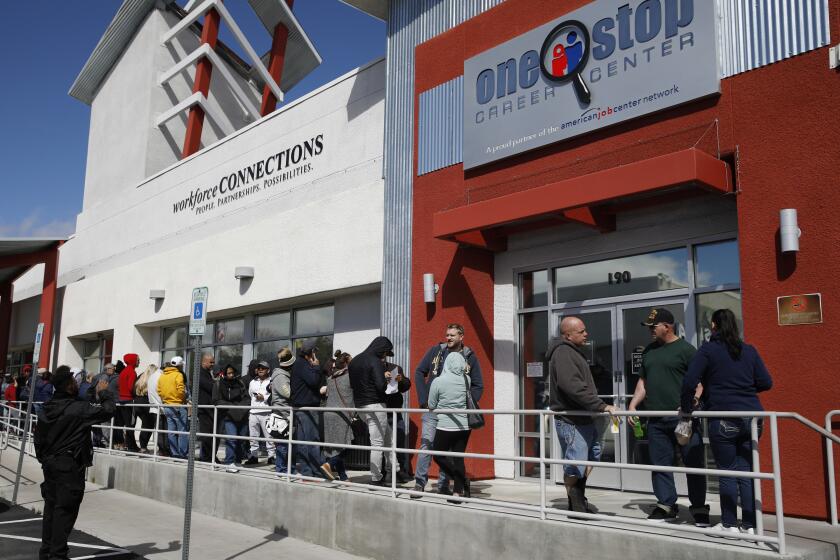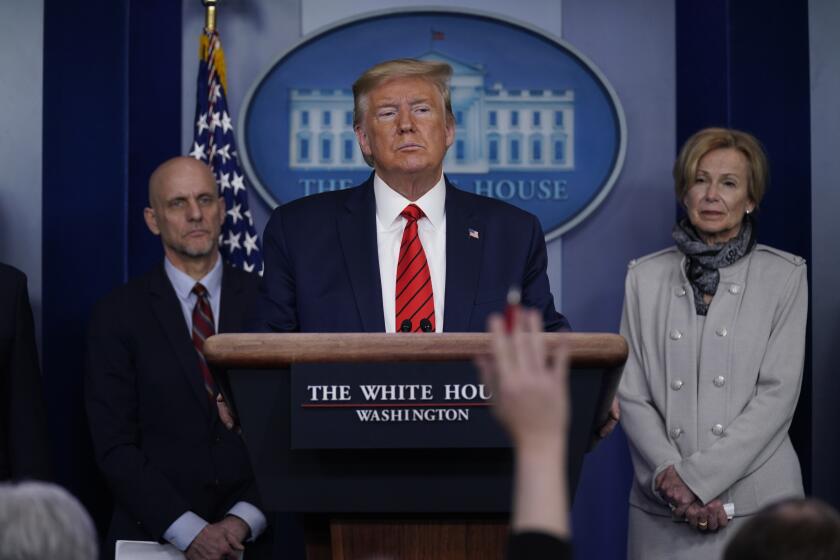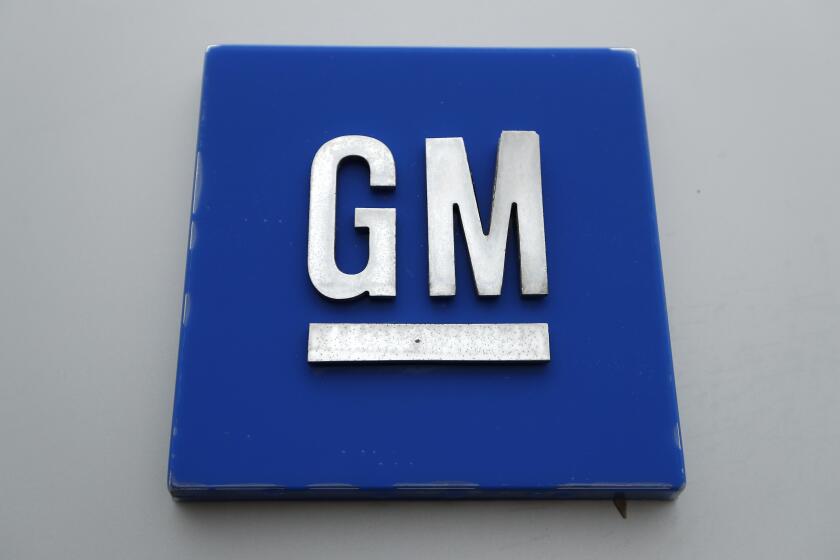Column: Here’s how one L.A. business owner is navigating government help for the coronavirus

- Share via
On Tuesday, Darryl Holter was feeling frantic.
The co-owner of two very different small businesses — the Larchmont neighborhood’s Chevalier’s Books and Felix Chevrolet in downtown Los Angeles — Holter was trying to complete applications for government small business loans for both so they could be sent to his bank before Friday.
“I’m afraid that on Friday the fund will empty out,” he told me. “I think everyone’s lining up for this.”
I’d like people to actually learn something from this. It’s unfair for employees and employers.
— Darryl Holter, Chevalier’s Books and Felix Chevrolet
Holter has reason for concern. The coronavirus fiscal rescue passed by Congress and signed by President Trump on March 27 set aside up to $350 billion for low-interest government-guaranteed loans for small businesses to help them survive the economic shutdown brought on by the virus and to prompt them to maintain their workforce or rehire those they’ve laid off because of the crisis.
The loans are to be doled out through commercial banks that were to begin processing applications Friday.
There are some indications from the Small Business Administration that the loans will be made available on a first-come-first-served basis. Since there are more than 30 million small businesses in the United States, a large proportion of which may qualify for the loans of up to $10 million each, the chances that demand will outstrip supply are significant. Even if the average loan turns out to be $100,000, the fund would cover barely 10% of America’s small businesses.
With one smaller small business (the community bookstore) and one larger small business (the Chevy dealership), Holter has been grappling with a wide range of imponderables.
President Trump’s hype of a potential treatment for COVID-19 gives false hope to virus patients and causes real harm to others.
Holter, who has taught history at USC and UCLA, written about Woody Guthrie, and spearheaded the revitalization of the Figueroa Street corridor in downtown L.A., acquired the businesses by different routes. Felix Chevrolet, which was founded in 1921, was acquired by his wife’s family in 1957 and is under his and his wife’s management.
Chevalier’s, which was founded in 1940 and today is the city’s oldest bookstore, was more of a “labor of love,” Holter says. He and Bert H. Deixler, a veteran Los Angeles commercial litigator, bought the shop in 2014 “to keep it going.”
They stabilized its declining finances, refurbished the premises, and launched author events and children’s readings.
“We took it from a store that was really struggling and turned it around,” Holter says. “We turned it into part of the intellectual infrastructure of the city in order to compete with Amazon and survive.”
Although Chevalier’s can’t continue the community events, for the moment, the store is offering free shop-to-front-door deliveries within a couple of miles of its Larchmont Boulevard location, and mail deliveries outside that zone. This has allowed Chevalier’s to keep four of its eight full- and part-time staff employed and to ready it for reopening after the coronavirus shutdown passes, Holter says.
Felix Chevrolet is permitted to keep its service department open, as an automotive repair and maintenance facility qualifying as an “essential” business according to state rules. But its sales department doesn’t qualify. About 25 employees are on the job in the service bays, but another 73 have been furloughed.
It’s time to think about how to get workers raises over the long term.
For business owners like Holter, the features of the government coronavirus rescue programs can be divided into two categories: good and confusing.
Start with the mandated paid sick leave provisions of the Families First Coronavirus Relief Act, signed by President Trump on March 18. The measure mandated 80 hours — that is, 10 average working days — of paid sick leave. “We looked at it and we told the employees we furloughed at Felix that they would be getting this,” Holter says.
But the Department of Labor subsequently issued rules stating that the leave would only be available to employees who lose work because they’ve been diagnosed with COVID-19, the disease caused by the virus, showed symptoms, were quarantined or isolated by government order or a doctor’s advice, or cared for a family member in those situations — and that documentation of the government order or doctor’s advice would be required.
Those are more stringent requirements than they seemed at first. Among other things, they say that sick leave isn’t due to those who lose their jobs because their employers have been shut down.
To comply with the rules, Felix won’t pay their sick leave. The dealership says it will, however, cover their 10% share of healthcare premiums through the month. And the workers will be eligible for the enhanced unemployment benefits — $600 a week in addition to California’s maximum benefit of $450 — funded in the most recent rescue legislation.
As for the SBA loan program, designated the Paycheck Protection Program, the application is gratifyingly stripped down. It’s a two-page form asking for a business’ average monthly payroll and number of employees (pre-virus). Banks aren’t required to verify the information upfront, and they can lend up to 2.5 times the average monthly payroll to cover wages, utilities and mortgage interest or rent.
The program’s key feature is that borrowers won’t have to repay the principal to the extent they maintain their payroll or promptly rehire employees they’ve let go. That’s an incentive to keep paying workers even while a business has shut down. But it’s also a source of confusion.
Holter understands that the loan program is designed so that if a business maintains 100% of its workforce through June 30, the entire loan principal is forgiven; if it retains half its workforce, 50% is forgiven and so on. “What I don’t know, and nobody seems to have an answer: At what point is this determined? Do I have to start hiring people as of the other day, or between now and June 30, or can I hire them all on June 28?”
In recent days, alarm about the economic impact of the novel coronavirus have turned conservatives who weeks ago were boasting about the shrinking of the U.S. government into raving Keynesians, proclaiming the virtues of deficit-financed economic stimulus.
The government hasn’t provided detailed guidance on these rules. But Holter says he hopes to put his workers back on the payroll as soon as possible.
As important as the goal is of maintaining payroll, the loan program is unnecessarily complicated. Compare it to Denmark’s program, in which the government is simply making grants to businesses covering 75% of workers’ pay, up to about $52,000 a year, during an expected three-month economic deep freeze, provided those workers stay home.
That’s plainly simpler than the American program, which anticipates workers being furloughed and rehired, and leaves the chance that businesses may discover later that they don’t qualify for loan forgiveness. The rollout of the SBA loan program, moreover, has been a mess. The Treasury Department didn’t provide participating banks with the program’s rules until Thursday, when it issued a 31-page directive. Even large commercial banks were saying Friday that they were so swamped with applications that they might not be able to process them all until the coming week.
There’s no question that the government has thrown businesses like Holter’s a lifeline. But he points out that they need a lifeline because the U.S. government has forsaken its responsibilities to Americans and placed them on the private sector’s shoulders.
“All this stuff is supposed to be done by the private sector — healthcare, pensions, getting face masks and ventilators — I’m dealing with life and death issues for my employees, and that’s what’s going on all over the country, rather than having a system that’s more rational and more cost-effective. I’d like people to actually learn something from this. It’s unfair for employees and employers.”
More to Read
Inside the business of entertainment
The Wide Shot brings you news, analysis and insights on everything from streaming wars to production — and what it all means for the future.
You may occasionally receive promotional content from the Los Angeles Times.














